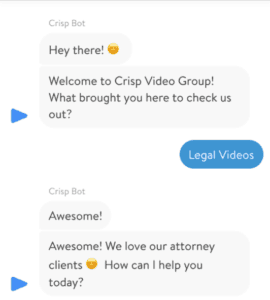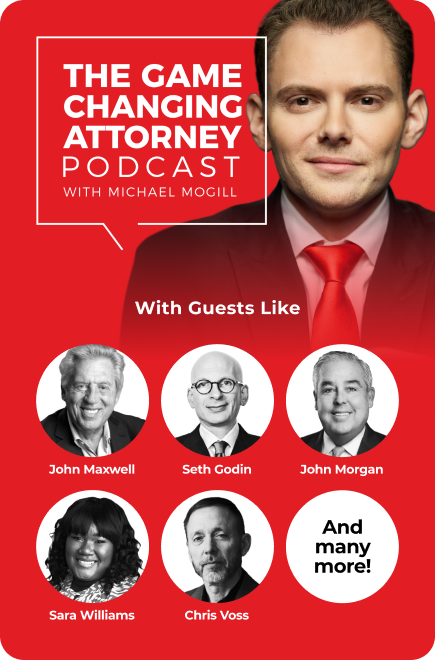This post was originally created for our friends at Great Legal Marketing. You can access the original post here.
The Importance of Quality Content
Creating and distributing content that is timely, compelling, and relevant can be a valuable source of lead generation for your law firm. But creating content that converts isn’t always as easy as it looks. Many of you are guilty of confusing keywords with conversions; conversion-focused content requires more than properly formatted headings and keyword-rich body copy.
If you want your content marketing efforts to drive more leads to your law firm, you need to focus more on value. Creating content that engages, educates, and enhances your brand helps you achieve the coveted role of “thought leader” and increases overall brand authority.
To get Crisp’s best guidance on defining your unique value proposition, communicating it through engaging video, and getting the most out of your brand video all in one comprehensive resource, check out The Game Changing Attorney. This is a book you’ll want to keep on your shelf to pull out every step of the way.
Here are a few ways to boost your content marketing efforts and create content that converts.
1. Incorporate More Emotion Into Your Content
Science has shown that the human brain is far more engaged by emotional storytellingthan logical facts. This happens for a few reasons:
- It’s easier for our brain to process and make emotional decisions than logical decisions, because emotional decisions are subconscious
- Emotions activate the part of the brain that allow us to feel as if we’re experiencing what we’re watching, reading, or listening to, allowing for a more immersive experience
- Our brains are wired to respond to emotional arguments, not logical arguments
Without emotion, we are biologically incapable of making decisions. Consumer behavior indicates that emotion plays a critical role in the beginning and ending stages of the decision making process. So by incorporating more emotion into your content, you can engage potential clients at crucial stages in the buyer’s journey – when they first interact with your firm, and when they’re making a decision about whether or not they want to work with you.
Incorporating more emotion into your content doesn’t mean every blog post needs to include a sob story, but it does mean you need to shift your priorities to focus on promoting emotional benefits. Create content that empathizes with the emotions your readers will be experiencing when searching for answers, be intentional with your messaging, but don’t neglect an opportunity to tug at the heartstrings. Powerful testimonials, heartwarming brand videos, and empowering educational videos can inspire action.
Check out this example of an emotional client testimonial from Derrick Law Firm, a personal injury firm in South Carolina. It tugs at the heartstrings while also establishing brand authority for Derrick Law Firm:
2. Include a Clear Call to Action
Potential clients will end up on your website with questions they don’t have answers for yet. In many cases, even if they find those answers they may not know that their situation requires an attorney. Including a clear call to action (CTA) will encourage them to take the first step towards addressing their legal needs.\
There is a fine line between including CTAs and publishing content with the sole focus of getting contact information. If someone spends a few valuable minutes skimming through your content only to find you’ve taught them nothing but your phone number, they’ll feel misled.

Instead, find ways to organically include CTAs within your content. Clear CTAs help you convert leads by directing visitors to take a desired action. Misplaced or misused CTAs can cost you valuable leads, so make sure you’re including them where they make sense (like at the end of a blog or right after a paragraph where you emphasize the importance of seeking legal help).
If you really want to make an impression, and you have a live chat program or popup message that supports this feature, you can customize your live chat so that the welcome message is unique to each blog.
For example, if you’ve published a blog about what to do after you’ve been arrested for a DUI, you can customize your live chat so a message pops up with a message like, “Have you been arrested for a DUI? We can help, just respond to this message!”
The same would apply to a pop up form platform like Sumo. At Crisp, we utilize both Sumo and Drift to engage with website visitors and convert leads. We customize our messaging based on the page the person is on, and build out sequences to filter out unqualified leads without human intervention.
3. Provide Value
Every piece of content you publish should be created with your ideal client in mind. Your ideal client persona is an amalgamation of traits from the best clients you’ve ever represented. By narrowing down that list of traits you will fine tune your content marketing by producing content that ideal persona will get value from.
There are two big questions you need to ask yourself when creating personalized content for your ideal client: “Why?” and “So what?”
First, ask yourself why you’re creating the content. Then, continue to ask yourself “So what?” while you’re creating it. You need be able to justify why a potential client should take the time out of their day to watch your video, read your blog, or open your email. The onus of responsibility is on you to make sure their time isn’t wasted.
Once you’ve created and published the content, you can use data to determine how best to distribute it. For example, you can use data about your clients’ online behavior to determine if they’re more receptive to receiving content via email, social media, or your website.
You can provide value through traditional forms of content such as blogs or newsletters, but also produce gated content like eBooks or more exclusive content that requires their contact information. This will allow you to get in touch with them after they submit their information and you can begin the process of converting them into a client.

Check out this example of a CTA to download an eBook we included with a webinar recording. Site visitors can get this eBook for free, and are more likely to do so once they’ve watched the webinar!
There’s a lot of back and forth in the marketing world about the advantages and disadvantages of gated content. Some think you should provide value without restrictions, while others argue that’s a waste of good content.
My recommendation is to use it in moderation. Don’t gate everything, but make sure your high-value content requires at least an email address in exchange for a download. You can then begin nurturing these leads and drawing them through the sales funnel.
4. Include Visuals
Adding visuals to your content can spark engagement and inspire action. Visual content such as pictures and videos make your content more aesthetically pleasing, which increases the likelihood they’ll stay on the page.
The use of visual content has increased by over 130%in the last two years, and that’s just with photos – not video content. Consider using visuals like infographics, blog headers, images for social sharing, and other forms of visual content to enhance your content and drive conversions.
Video can also greatly enhance your content marketing efforts, and here’s why:
- 90% of users say videos are helpful in the decision-making process
- Videos can boost landing page conversions by 80%
- A third of all the time people spend online is dedicated to watching videos
Video content is so powerful because it combines all of the benefits of a strong content strategy: it’s emotional, it’s engaging, it connects with the audience, and it’s memorable.
To get our best guidance on defining your unique value proposition, communicating it through engaging video, and getting the most out of your brand video all in one comprehensive resource, check out The Game Changing Attorney. This is a book you’ll want to keep on your shelf to pull out every step of the way.
You can leverage video across every part of your website and content strategy. You can analyze your site traffic to identify which blog posts get the most traffic, then produce an educational video that corresponds to that topic, or vice versa. You can produce testimonial videos to build social proof, or create a branding video that introduces and humanizes your firm.
To put the power of video in perspective, check out this video for Personal Injury Attorney Matt Miller in Omaha, Nebraska:
A powerful content strategy can be a major source of lead generation for your firm, provided that you constantly focus on value. If you create valuable content, the SEO benefits will follow. To create content that converts, ensure you’re always producing content with your ideal client in mind, and don’t shy away from visual or gated content.If you have any questions about ways to incorporate legal video your content strategy, feel free to reach out to our team.








